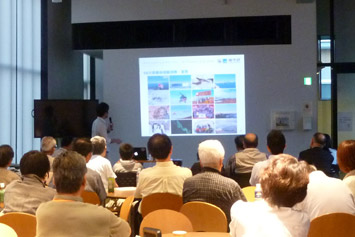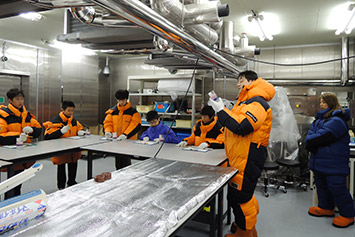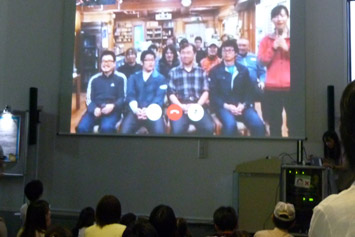National Institute of Polar Research

Providing the public with information and topics on “Antarctic and Arctic Research Today”
Polar Science Museum, the National Institute of Polar Research, provides information on historical as well as current state-of-the-art research activities and results in an easy-to-understand forum. Here, visitors can touch and experience objects from 4.6 billion years ago to present day objects. Brief descriptions on our more popular exhibits are provided below.
Exhibits

"KD604 Snow Vehicle", employed for Japanese South Pole travel in 1968, and certified as a Mechanical Engineering Heritage machine in 2014
History - Heading for Antarctica
In 1910, Nobu Shirase launched his expedition with the aim of reaching the South Pole. Forty-six years later, the first Japanese Antarctic Research Expedition (JARE) left for Antarctica abroad the research ship Soya and landed on Ongul Islands on January 29, 1957. The expedition named the surrounding area as “Syowa Station”. This marked the beginning of JARE.

Drilling into deep layers of the ice sheet
Atmosphere & Ice - Exploring the earth’s environment
Antarctica is covered with ice sheet made of snow. Buried within this ice is a record of the earth’s climate and environment of the distant past. Man’s impact is slight in Antarctica, which makes this area an ideal location to study global environments in the past and present.

TACHIHI Aurora Theater
The theater shows full-color images of auroras filmed in Antarctica and the Arctic on a four-meter-diameter domed screen. Experience the wonder of auroras dynamically dancing across the sky for yourself. Experience our new TACHIHI Aurora Theater!

Aurora - Exploring the wonders of mysterious lights
Why does an aurora glow? Are the auroras in the Antarctic and the Arctic the same? Where can we see auroras? Auroras are not only beautiful, but full of wonder and mystery. Plenty of information about the universe is contained in their colors, shapes and movements.

Syowa Station live cam
Syowa Station
Established in 1957 on East Ongul Island, Syowa Station started with 11 expedition members overwintering in four buildings that were little more than mountain lodges. A half-century later, Syowa Station has become a world leading scientific station made up of more about 70 buildings with internet connections, floor heating, private bedrooms, bathrooms, and flush toilets.

Martian meteorite
Rocks & Meteorites -- Exploring the solar system’s 4.6 billion-year history
Meteorites are rocks fallen to earth from outer space. Meteorites can be discovered in Antarctica and many have been collected by JARE. Rocks, unlike meteorites, are formed here on earth. Studying rocks can tell us how the continents were formed and provide information about environmental changes in the past.

Wildlife - Exploring life and ecology in extremely low temperatures
Polar marine ecosystems are very rich. In addition to ice algae growing in sea ice, there are krill, fish, birds, and mammals living in Antarctic waters. The environments on land are much harsher than those in the sea. Plants such as moss and lichen, as well as tardigrada and other microorganisms, live in special habitats where liquid water can be obtained. Let’s explore this mysterious life surviving in such harsh environments.

The Arctic
The images of the Ny-Ålesund NIPR Observatory in the international research village, and representative specimens of Arctic fox and moss etc. are on display. Visitors can see various research results on the Arctic with commen-tary panels and videos.

Bronze Statues of Sakhalin Dogs
They worked for the First JARE (1956-1958) and remained at Syowa Station.
Events
There are also exhibits for children such as “Become a Polar Researcher!” as well as "Science Café" and special exhibition and live chat from Antarctic Syowa Station.

Special exhibits

Science cafe

Workshop for children “Become a polar researcher!”

Live chat from Syowa Station
Upcoming events, see www.nipr.ac.jp/science-museum/ (in Japanese)

Polar Science Museum, National Institute of Polar Research
10-3, Midori-cho, Tachikawa-shi, Tokyo 190-8518
- Museum hours : 10:00-17:00 (no entry after 16:30)
- Closed : Sundays, Mondays, national holidays, New Year holidays, Every month third Tuesday
*The museum may also close temporarily for maintenance.
- Admission : Free








